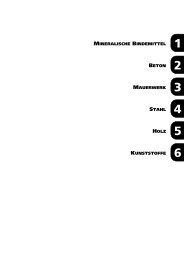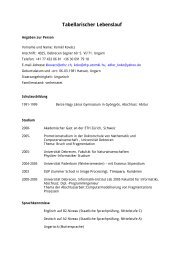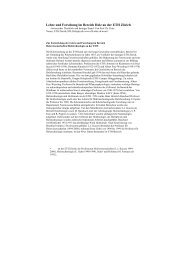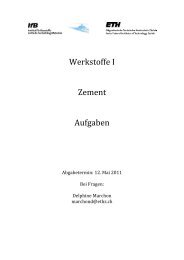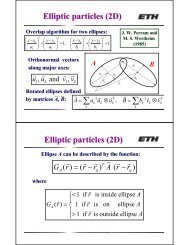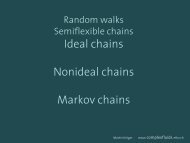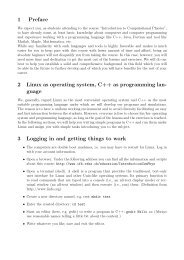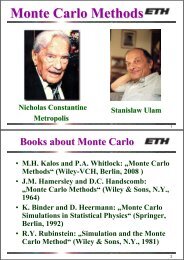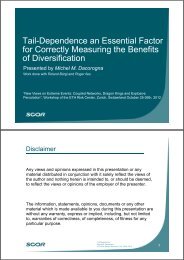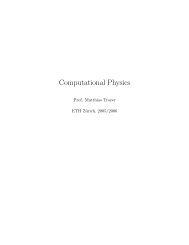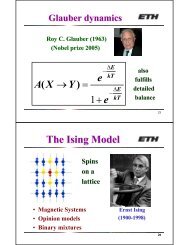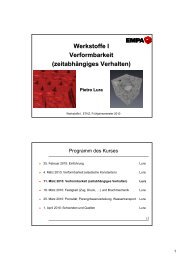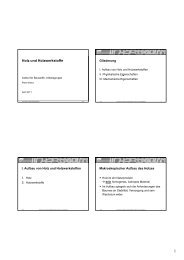Here - Institute for Building Materials - ETH Zürich
Here - Institute for Building Materials - ETH Zürich
Here - Institute for Building Materials - ETH Zürich
You also want an ePaper? Increase the reach of your titles
YUMPU automatically turns print PDFs into web optimized ePapers that Google loves.
BEHAVIOR OF CONFINED WATER IN POROUS C-S-HP. A. Bonnaud 1 , Q. Ji 1 , B. Coasne 2 , R. J.-M. Pellenq, K. J. Van Vliet 31 Department of <strong>Materials</strong> Science & Engineering and Department of Civil &Environmental Engineering, Massachusetts <strong>Institute</strong> of Technology, 77Massachusetts Ave., Cambridge, MA, USA.2Institut Charles Gerhardt Montpellier, CNRS UMR 5253, ENSCM, 8 rue de l’EcoleNormale, 34296 Montpellier Cedex 05, France.3 Centre Interdisciplinaire de Nanoscience de Marseille, Aix-Marseille Université,UPR 3118 CNRS, Campus de Luminy – case 913, 13288 Marseille cedex 9, FranceINTRODUCTION: To improve the durability ofconcrete under extreme conditions, it isparticularly important to understand damagemechanisms within the cement paste that bindsaggregates. The multiscale porosity inherent tocementitious materials implies that water may bepresent as liquid, solid, and/or gas depending onthe thermodynamic conditions (temperature,pressure, ion concentration). It is thus appreciatedthat water may be both the source and the mediumcausing damage in cement paste. <strong>Here</strong>,computational simulations are particularlyadvantageous because water properties innanoscale pores (≤1 nm) are challenging to accessexperimentally.M<strong>ETH</strong>ODS: Our study is based on the calciumsilicate hydrate phase 1 (C-S-H), the primarybinding constituent in cement paste. We employsemi-Grand Canonical Monte Carlo techniques toconsider how the water content within and betweennanoscale C-S-H volumes or “grains” changes as afunction of the relative humidity (% RH) at anambient temperature of 27°C. To relate the effectof the water content in the cement paste on thecohesion, we computed pressures due to the fluid(water and calcium ions) in the direction normal tothe grain surface. Negative pressure indicatescohesion, and positive pressure indicates repulsion.Two situations are considered: (i) inside a C-S-Hgrain and (ii) between two C-S-H grains separatedby varying distances up to 1 nm, reflecting theclose proximity of such grains within cementpaste.RESULTS: We found that calcium ions areresponsible <strong>for</strong> the overall cohesion in thesematerials (giving rise to a negative pressure).However, the role of water in reducing orrein<strong>for</strong>cing this intergranular and intragranularcohesion depended on separation distance betweenC-S-H grains. The reduced cohesion at separationdistances < 5 Å and increased intergranularcohesion at intermediate distances of 5-10 Å wereboth amplified with increasing %RH (fig. 1).CONCLUSIONS: These findings give <strong>for</strong> the firsttime an atomistic picture of the confined fluid andits induced pressure effects on the solid structure inthe lowest porosities of cement at ambienttemperature and 100% RH. It is a first step tounderstand cement paste damage processes inmore extreme conditions as high/low temperatures,high pressures, and/or various ionic concentrations.Fig. 1: Pressures applied by the fluid (water (H 2 O)and calcium ions (C w )) in the direction normal tothe grain surface as a function of the distancebetween the C-S-H grains at 100% RH. The blackcurve is the total pressure. The contribution ofwater to the pressure is indicated with blue filledcircles. The contribution of the calcium ions isindicated with red filled squares.REFERENCES: 1 R. J.-M. Pellenq, A. Kushima,R. Shahsavari, K. J. Van Vliet, M. J. Buehler, S.Yip, and F.-J. Ulm; 2009; PNAS; 106 (38):16102.ACKNOWLEDGEMENTS: This work wassponsored by the U.S. Department of HomelandSecurity, Science and Technology Directorate,Infrastructure Protection and Disaster ManagementDivision: Ms. Mila Kennett, Program Manager.The research was per<strong>for</strong>med under the direction ofDr. Beverly P. DiPaolo, Engineer Research andDevelopment Center (ERDC), U.S. Army Corps ofEngineers. We acknowledge funding from the MITConcrete Sustainability Hub, supported by thePortland Cement Association and National ReadyMix Concrete Association.34



